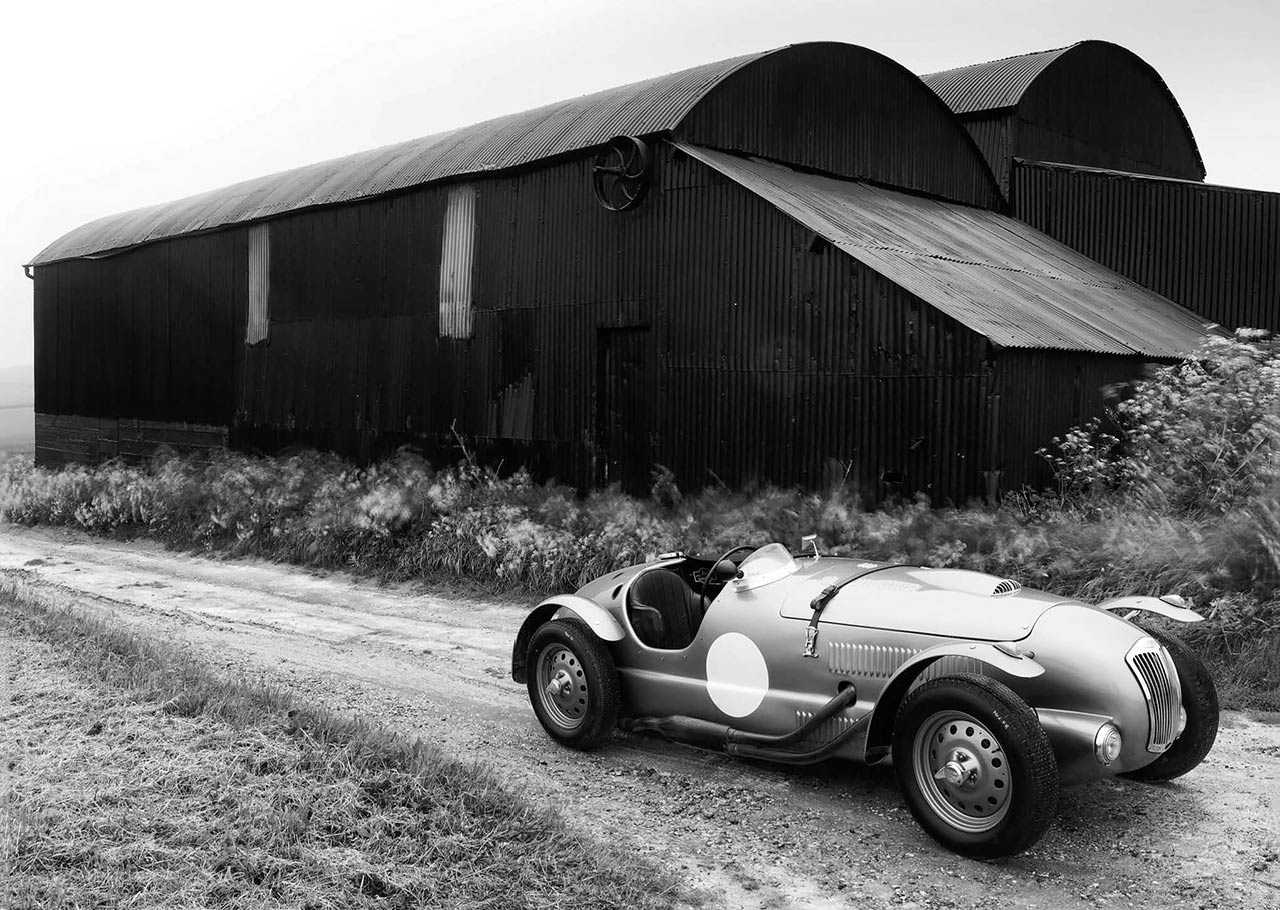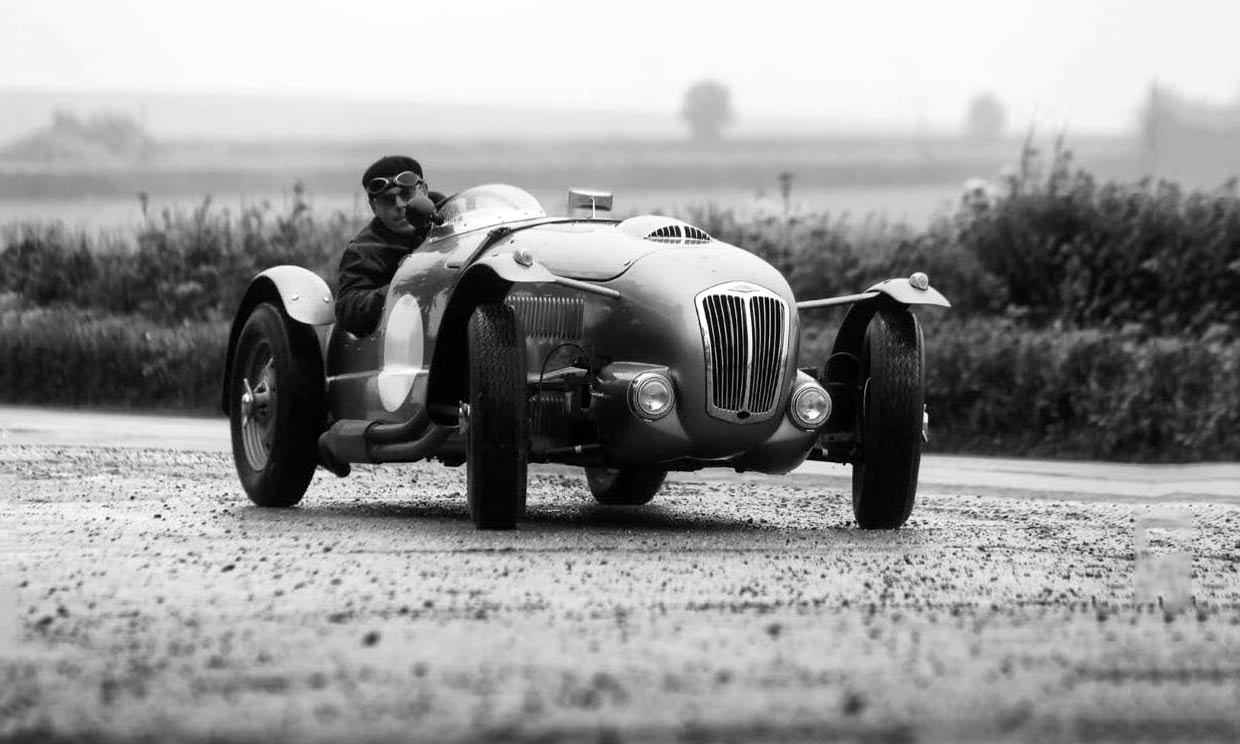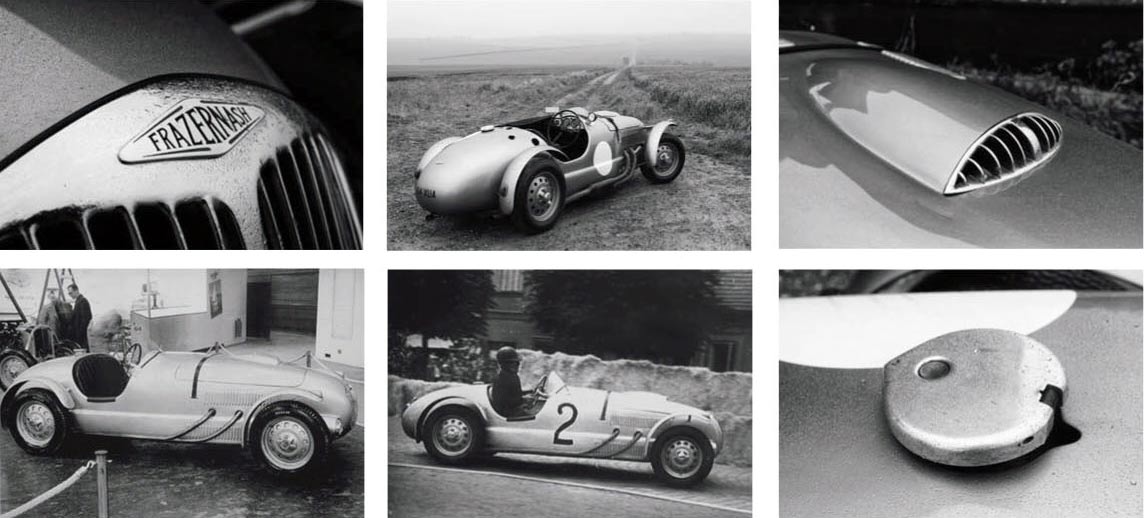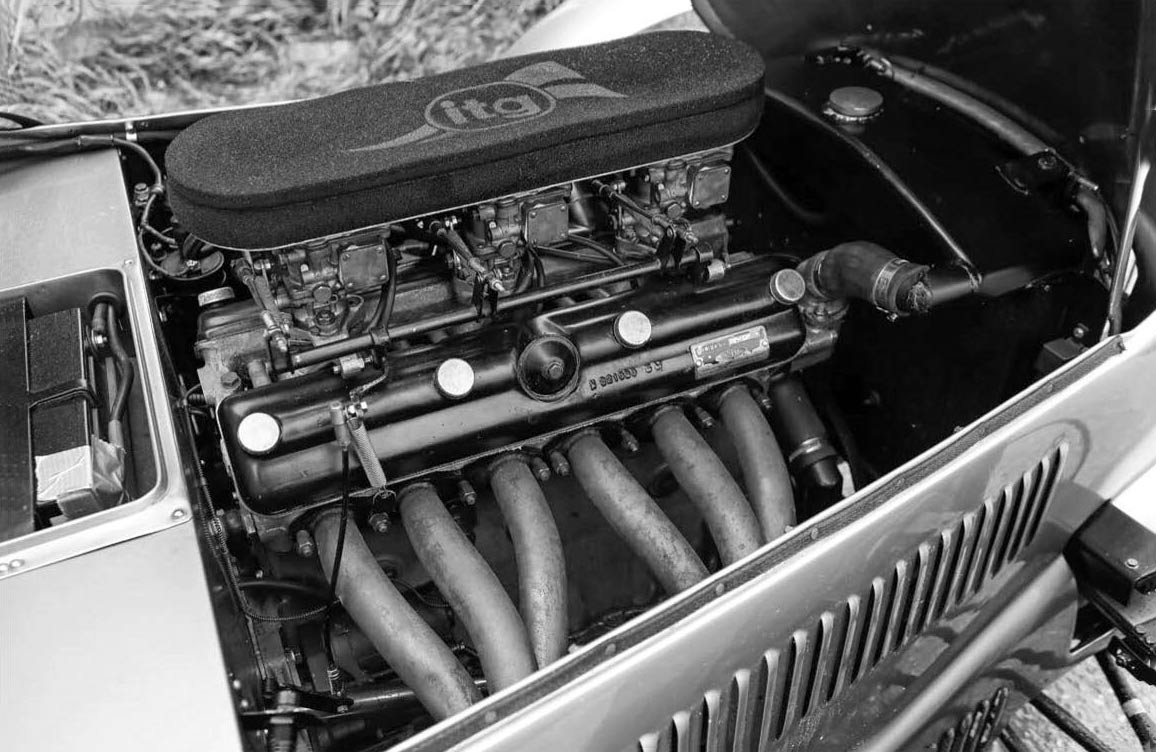
Walsh fulfils a lifelong dream in a Frazer Nash High Speed. Nash’s Bristol pioneer How the High Speed set the template for FN’s famous ‘sixes’. The British racing masterpiece with a German heart. This is where the story of the sensational Bristolengined Frazer Nash begins, says Mick Walsh as he falls for the charms of a sublime High Speed. Photography Tony Baker/Frazer Nash archives.
As a student watching historic racing, a silver Frazer Nash High Speed driven with aplomb by Roddy McPherson was a car that I craved to try for myself. The charismatic Scot was a highlight as he chased after bigger, younger machines. His car looked sleeker than later Bristol-powered Nashes and, as I discovered after chats with another hero, Denis Jenkinson, chassis FN4 was the first of the new cycle-winged models from the Isleworth firm.

Fast-forward four decades, and finally that dream test is possible but the late spring day couldn’t have contrasted more with my longimagined union with this rorty six-cylinder sports-racer. Strong winds, relentless drizzle and wet roads overwhelmed my spirits, but the weather somehow made the day more memorable once at the wheel around the Essex borders.
In my mind, the misty monochrome light helped to conjure the immediate post-war era in the Middlesex workshops, and the development of one of the greatest British sports cars – albeit with a borrowed Bavarian template.
After a few years struggling with Bristol management and unresolved prototypes, the formula came right with the fourth post-war Nash. The sleek new High Speed was the talk of Earls Court in 1948, with its low headlights moulded into the streamlined nose cowl, and the cigar-shaped thin aluminium body with distinctive swage lines. At last, the fledgling concern looked set to carry on the racing tradition set by GNs and Chain Gangs from the inter-war years.
With its outside exhaust, wide single bonnet strap, low, minimal ’screen, doorless cutaway sides, saucer-sized fuel filler cap and neat rump, the first ‘Competition Model’ epitomised every wealthy enthusiast’s aspirations to drive, compete, and drive home. You knew from the moment it arrived – purposeful and spartan – that this was a true sports car. As the likes of Dorino Serafini, Tony Crook and Jack Newton proved, it was capable of upstaging anything on twisty road courses. The inspiration was undoubtedly the brilliant BMW 328, and even the design was partly masterminded by Fritz Fiedler, a seconded German engineer. Yet the repackaging of the Teutonic sensation still somehow had a uniquely English character that went beyond its imperial measurements.
As soon as you step into the low seat and slide under the broad, three-spoke steering wheel, this High Speed feels like pulling on a favourite bomber jacket. Everything from the pedal spacing to the evocative view down the shapely louvred bonnet looks and feels right. Turn the ignition key, flick on the fuel pumps, thumb the starter, and immediately that raucous Bristol bark blows away any blues on a grey, damp afternoon. “Watch those Dunlop R5s in the wet,” warns Patrick Blakeney-Edwards, the Nash guru whose respected team looks after this car.

Almost straight out of his Buntingford base, the lack of grip is clear on a roundabout. As the eager 140bhp ‘six’ lets rip, the back breaks away on greasy tarmac but it’s all very controllable. The sound down the long exhaust that runs just under my elbow is euphoric, the sharp cackle evoking lap records at Silverstone. With cold linings, the drum brakes initially feel dead, but the sublime steering instantly brings a broad smile despite the rain. You rapidly forget the weather and just revel in its forgiving nature.
Time is limited for this unique drive, so my course is set for rewarding, well-known back roads near Royston. Despite the wet, the High Speed immediately feels on your side, its seemingly viceless character encouraging a rapid pace across the rolling, open route. Over-drive a Bristol- powered Nash, and its charms will wash by you. This is a car that you relax into and marvel at the beautifully weighted, precise steering as the engine yowls away in third through fast corners. The big wheel may appear vintage, but it requires just the slightest movement to guide this captivating machine past the apex. Match that light, direct steering touch to the instant torque and the appeal is addictive. Just easing off for a turn brings another grin, the feisty backfire stirring vivid images of cross-continent blasts to Geneva or Brescia in the late ’40s.
For such a low, racy-looking car, the High Speed rides the bumps really well, and there’s little kickback from the rack-and-pinion steering – even when the independent front end finds a big hole. The short, rapid action through the stumpy lever – complemented by the instant throttle – means that you never tire of doubledeclutching to save the synchros. The strong tubular chassis leans a little through the tighter turns, and the inside rear wheel spins away if you are overly eager with the power, but the balance is inspiring. It just begs you to go quicker.
By modern standards, the performance figures look tame – with 0-60mph in about 8 secs and a top speed of 120mph – but it more than lived up to its name in the late 1940s, gunning across Europe to events. My favourite images of these Nashes are of HJ Aldington delivering FN7, now owned by Nick Mason, to the Geneva Salon. Why waste money on a transporter for the European debut when you can drive the exciting new car? With its mudguards and nose cowl taped up to protect the paintwork from chips, and ‘Aldy’ snug in his RAF bomber flying gear, he simply headed for the ferry and drove to Switzerland. The transformation of the second silver High Speed at the local BMW dealer would convince you that it was another car, but that’s how Frazer Nash did things. The same pattern worked for the race and rally cars when taken to Italy, with Aldington’s lucky son John taking time off school for the exciting delivery trip to Brescia. Such epic runs – no doubt Aldington argued – doubled as development testing as he headed off for another motoring adventure.
The evolution of the Bristol-powered Frazer Nash dates back to AFN’s import and sales of the fabled 328. Aldington knew that the design was way ahead of its time and still a potential market leader. So he went back to Germany straight after WW2 to collect his crashed 328 prototype but mysteriously returned with one of the 1940 Mille Miglia team cars. Rebadged Frazer Nash, and with minor revisions to the grille, it was initially presented as the new model. With a deal struck for Bristol to build engines under licence exclusively for AFN, Aldington brought together a talented team including Fiedler (right) who was closely involved with the 328’s engineering. First design engineer John Perrett, and later Irvin Ashcroft, refined the A-shaped chassis with stronger, tubular bracing while further honing the suspension.
The first British-built prototype was bodied and partly completed by Fox & Nicholl but, compared to the beautiful Mille Miglia 328, it was an ungainly looking roadster that Aldington nicknamed ‘Bath Tub’. The second chassis was sent to Touring where the early Bristol bodies were being built and the result was the ‘Superleggera Spyder’. The costing no doubt gave Aldington a shock, so it remained a one-off with bodywork for future models made in England. The ‘Bath Tub’ shell was then fitted to a third chassis but, after a failed sortie on the ’1949 Mille Miglia, owner Michael Tenbosch sent it back to Isleworth demanding a refund or legal action.
The vehicle was later dismantled and scrapped. All finally came good with the fourth car, featured here. Its revised Ashcroft-type chassis was fitted with Bristol dampers and, with the first cycle-winged body made by Coventry Motor Panels, the pattern was set for a glorious new era.
The first three cars have been broken up or lost, so FN4 is the oldest Bristol-engined Nash and, as my drive confirmed, it’s still in superb fettle. Sprayed silver, with a distinctive single racing windscreen, it looked sleek when unveiled to the press on 26 October 1948 at the first post-war Earls Court Motor Show. Story has it that the 18swg aluminium bodywork was so thin that it dented easily when pushed into the exhibition.
After the more refined Touring-bodied Spyder FN2, Aldington was clearly targeting wealthy racing amateurs with the new model, which featured a 3.54:1 back axle with aluminium housing and a high-compression 120bhp motor.
Frazer Nash had a successful show, with the Shah of Iran splashing out a hefty £2500 for FN2 as his 29th birthday present, while FN4 was ordered off the stand by František Dobrý, a rich Czech businessman. Although the car had a new Bristol engine (1055), Dobrý’s deal required that it be removed and the Nash sold without a motor for £954 – probably to avoid hefty import tax.
Never registered new in the UK, the powerless beauty was delivered to the London docks in December and shipped to Czechoslovakia, where it was fitted with a BMW engine – possibly from the 328 that Dobrý had previously raced.
Dobrý competed extensively with the High Speed during 1949 and 1950 but never ventured out of his homeland. As well as hillclimbs, he entered both the 1949 and 1950 Czechoslovakia Grands Prix, with the new Nash no doubt ideally suited to the 11-mile Masaryk road course, its unsilenced 2-litre ‘six’ rasping through the tricky corners in the Žebˇetin and Kohoutovice woods. Dobrý finished 11th in 1949 after a 3-hour race.
Brit Peter Whitehead won in the exotic Ferrari 125 ahead of the GP Talbots, Maseratis and a Tatraplan Sport T602 driven by Bruno Sojka. Dobrý continued to compete through 1950, finishing seventh at Brno, but no international events were held until the ’60s after Czechoslovakia became part of the Warsaw Pact. Little was heard of FN4 but, just after the Prague Spring, Donald Hill ventured to Eastern Europe to find Dobrý’s Nash. In the winter of ’1969, he uncovered the car in fine condition with just a few mods including vents around the nose and extra headlamps. Back in Britain, Hill registered the returning High Speed WAY 784G and, in July 1973, it was sold via dealer Harold Webb to the popular Scottish ace McPherson. When not campaigning his F2 Cooper, McPherson would race the High Speed. In the traditional style, he would usually drive the car to the tracks from across the border, and then drive home again.
After 13 years, McPherson decided to keep his 328 and sell FN4 to Sir Anthony Pilkington, who regularly entered the VSCC Pomeroy Trophy with it. The innovative glassmaker and chairman of the Lancashire business Pilkington Brothers, Sir Anthony was a devotee of PG Wodehouse and loved fast cars – having owned a Ferrari 250GTO and Maserati 300S – but the Frazer Nash was a favourite among all the exotic Latin machinery. As well as competing, he often used it for the commute to his St Helens factory.
Later owners included Peter Rae before American enthusiast Ned Spieker acquired FN4 in October 2007. Thankfully, the Californian property tycoon prefers to keep the High Speed in the UK. He has competed with it several times at the Grand Prix de Monaco Historique, following in the tracks of David Clarke, who came fifth with a Le Mans Replica in 1952. Blakeney-Edwards counts two second places at Monaco in a MkII Le Mans Rep as career highlights: “The car is perfect for a street circuit.
It feels so nimble and the fantastic brakes just don’t go off. We can get 180bhp from a Bristol, but the extra power makes the engine quite fussy. We limit revs to 6000rpm, although you can go to seven but the top end gets so busy it feels cruel.
The handling really suits Monaco and you can be brave, but you’re goosed if you get stuck behind a more powerful car. Qualifying well is everything, but the MkII is a potential winner. The Le Mans Replica may not be the fastest but it’s just so controllable. Even when you outbrake yourself into corners and it gets ragged, you rarely lose control. It’s sublime to race, but also a brilliant road car. I still get a buzz every time I drive one.” He also rates FN4: “There’s something special about that early car. It feels really planted but also the ride is softer. The steering rack is mounted slightly lower, so there’s less bumpsteer. The body is totally original and, when Keith Roach made a new body for FN6, this was the perfect reference. We even found evidence of the louvres cut into the nose cowl by Dobrý, and still have the original aero-screen.”
With Le Mans Replicas valued at between £700k and £1m, depending on history and provenance – and rebuilds of Bristol engines up to £50k – these are now dream machines. But, had I the funds, a High Speed would be top of my list. What better way to celebrate the Targa Florio’s centenary than a road trip to Sicily to retrace the famous road course where Franco Cortese drove the fifth Competition model, FN9, to the sole victory for a British marque in 1951?
It’s a car you’d never tire of, and it’s easy to see why owners adore them – even those with more exotic machinery such as Mason, who bought FN7 in 1995. ‘It is always an immense pleasure to drive, embodying all the characteristics of an old car in its look and feel, but delivering relatively modern performance and comfort,’ he concluded in his superb book Into the Red. ‘I like to think of it as the mechanical equivalent of a golden retriever.’ Returning FN4 to Blakeney- Edwards’ workshop – even after a wet evening drive – was a real wrench and the temptation to take it home was almost too much.

Clockwise, from above: High Speed is beautifully balanced through corners, even in wet; bonnet vent for the triple downdraught Solex carburettors; large quick-release fuel filler; Dobrý racing FN4 in the Czech Grand Prix, where it ran with full road trim.

Above: BMW’s crosspushrod ‘six’ was built under licence by Bristol and can now produce up to 180bhp with ‘optimised gas flow’; early High Speed has no bootlid; Isleworth’s most famous; spotless FN4 at Earls Court with stripped chassis behind.
‘IT IMMEDIATELY FEELS ON YOUR SIDE, ITS VICELESS CHARACTER ENCOURAGING A RAPID PACE’
Fritz Fiedler 1899-1972
German engineer Fiedler was the unsung genius behind the Bristolpowered Frazer Nash family. Before joining BMW in 1932, his CV already included quality cars for Stoewer and Horch, where he teamed up with ex-BMW motorcycle designer Hans Schleicher to create the successful sidevalve straight-eight. This talented duo joined BMW in the early 1930s, Stoewer focusing on two wheels in Munich, while Fiedler, aged just 32, headed up car development in Eisenach.
The pair transformed the image of the Bavarian firm, with designs that were years ahead of their rivals and, once the cars were sorted for racing, they upstaged the competition, winning the Mille Miglia and the TT. Fiedler didn’t design the BMW straight-six, but he developed the unit for first the 315 and, later, the 328s. Without his work on the cylinder head – with its high camshaft operating overhead valves via pushrods running across the engine to actuate the exhaust side – the impressive family of BMW/Bristol-powered sports cars including Frazer Nash, AC, Veritas, Cooper, Arnolt and Lister might never have happened.
Fiedler’s last pre-war car design was the 90mph 335, a refined saloon aimed at the new autobahns, before he switched to military vehicles during WW2. Come peacetime, and with BMW’s factories flattened, the gifted engineer was enlisted by HJ Aldington to join AFN to help develop the Bristol 400 and Frazer Nash sports cars. As well as continued refinement of the famous ‘six’ for licensed Bristol production, Fiedler also played a key role in chassis, suspension and body design from his Isleworth office. Colleagues recall a kindly and charming man, who everyone admired for his technical prowess. After three years in England, Fiedler returned home, first to Opel and then back to BMW where he guided the evolution of the stop-gap 700 and the new V8 range. This impressive second act climaxed with leading the design of a new generation of four-cylinder saloons – starting with the 1500 – that became the foundation of BMW’s success in the 1960s. His attachment to the marque continued after retirement in 1966 and he’d still visit the factory as a consultant every day for another two years.

Clockwise: High Speed still has its race seat fresh from competing at Monte-Carlo, but the original can go back at any time; vivid performance always brings a smile; chassis FN7 ready for Earls Court debut; Fox & Nicholl built prototype body, which was scrapped.





